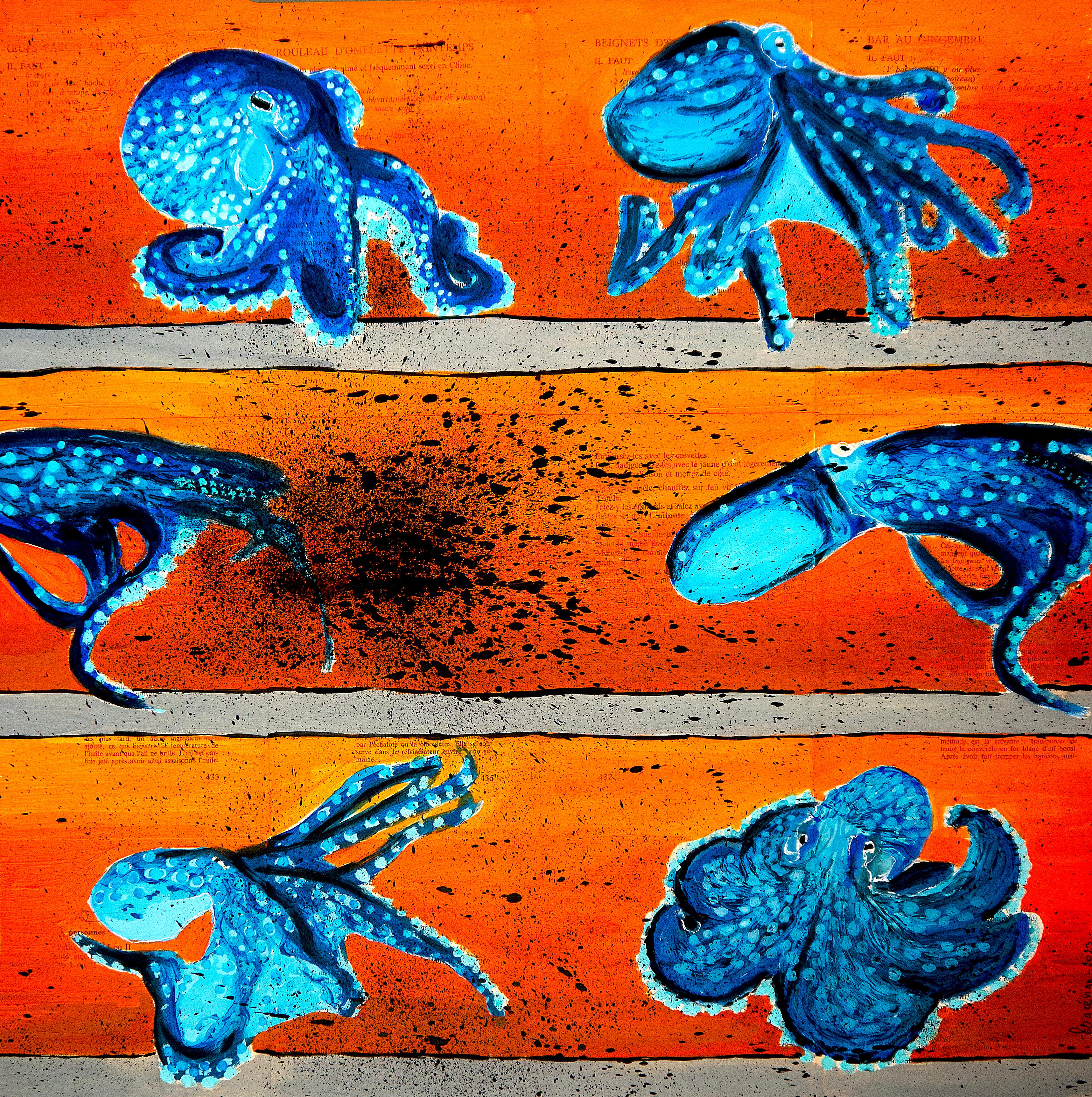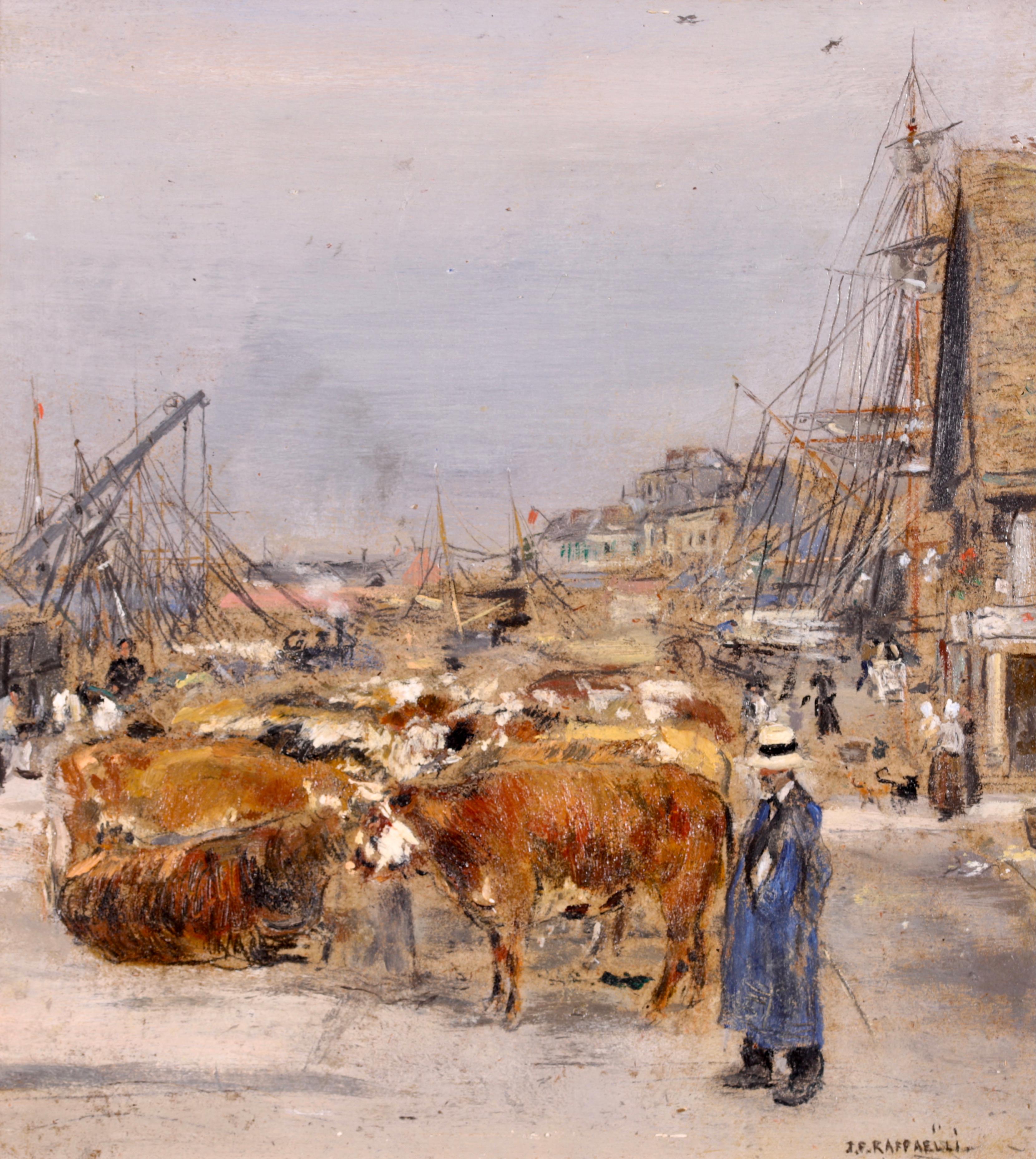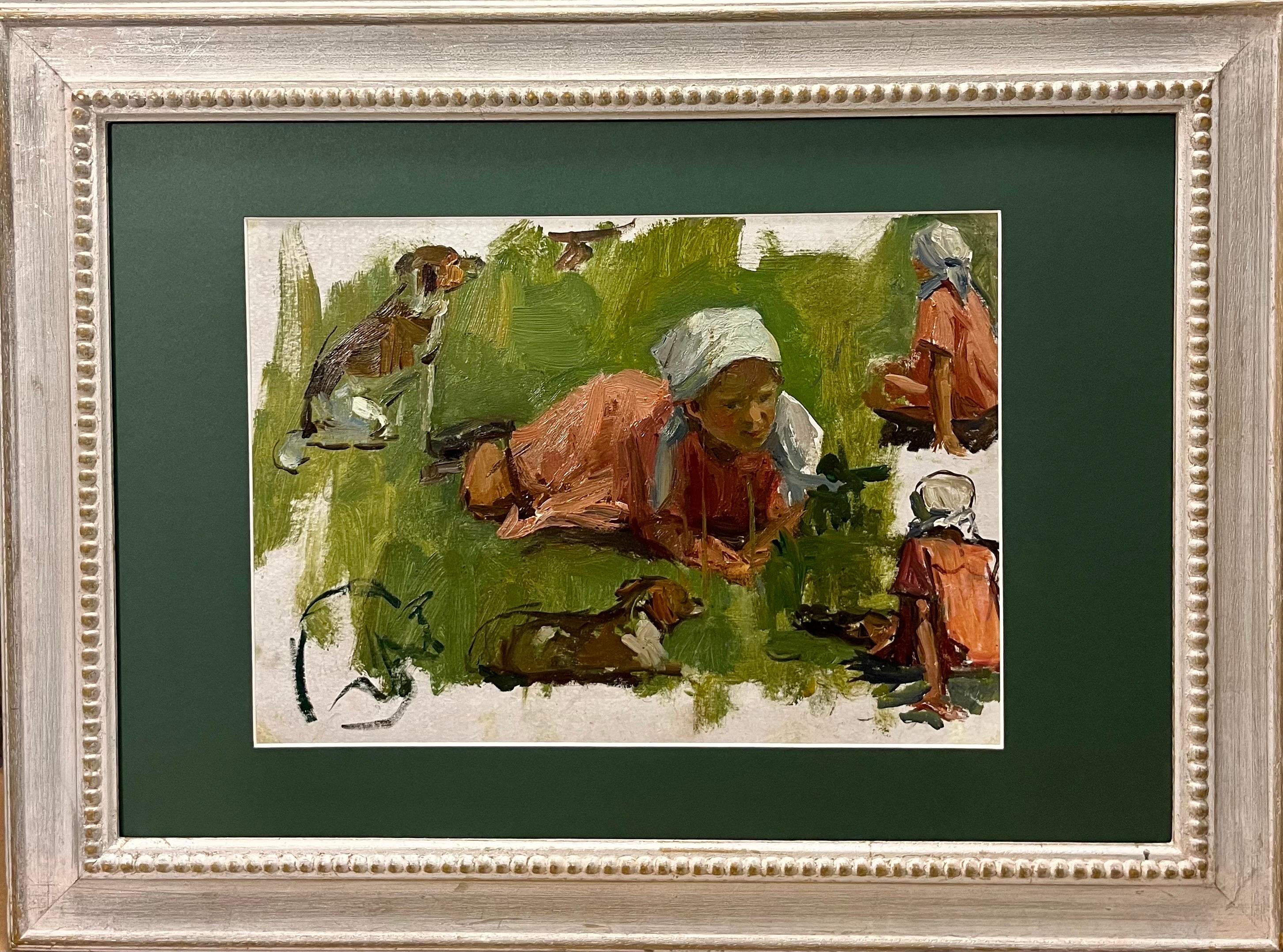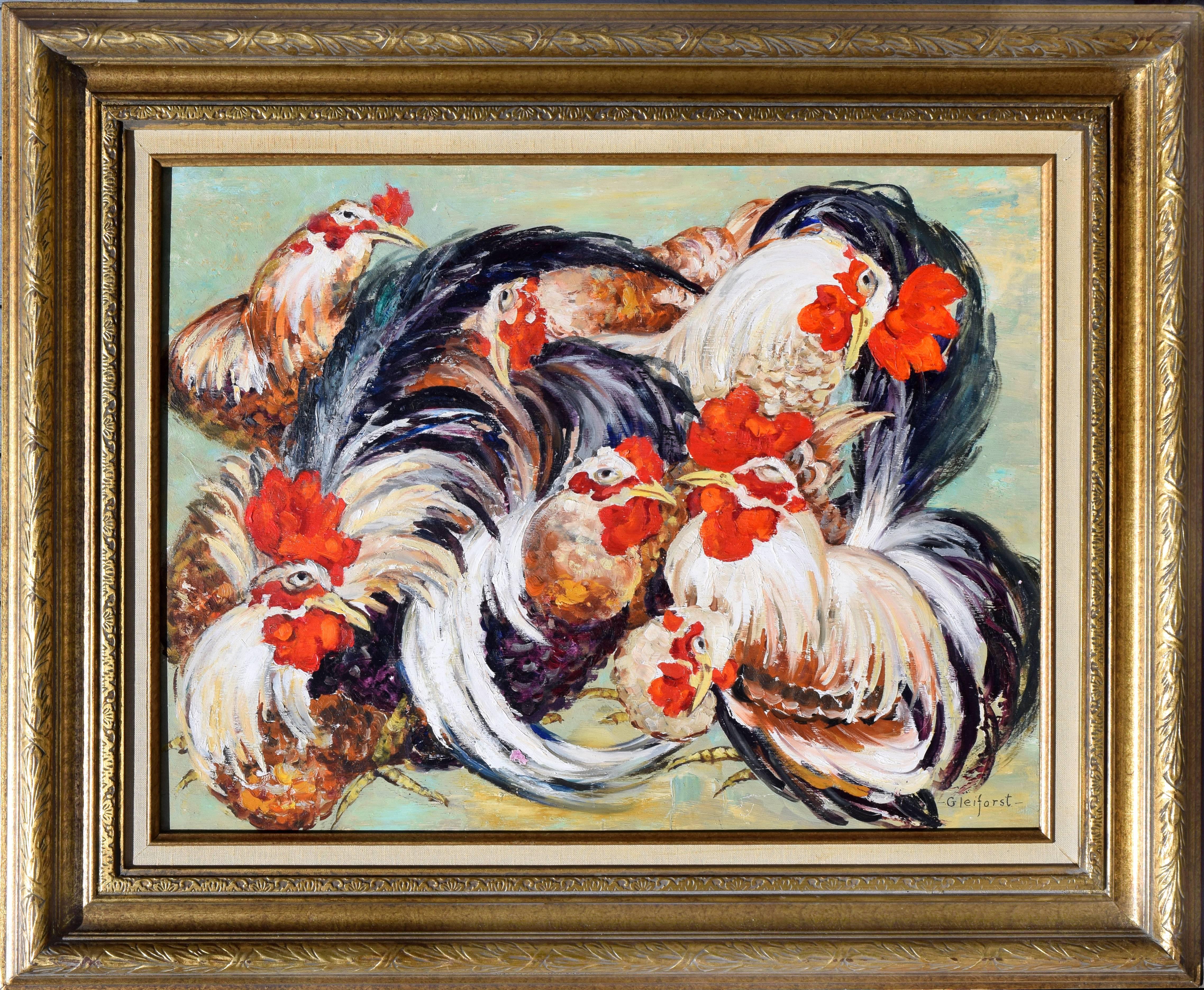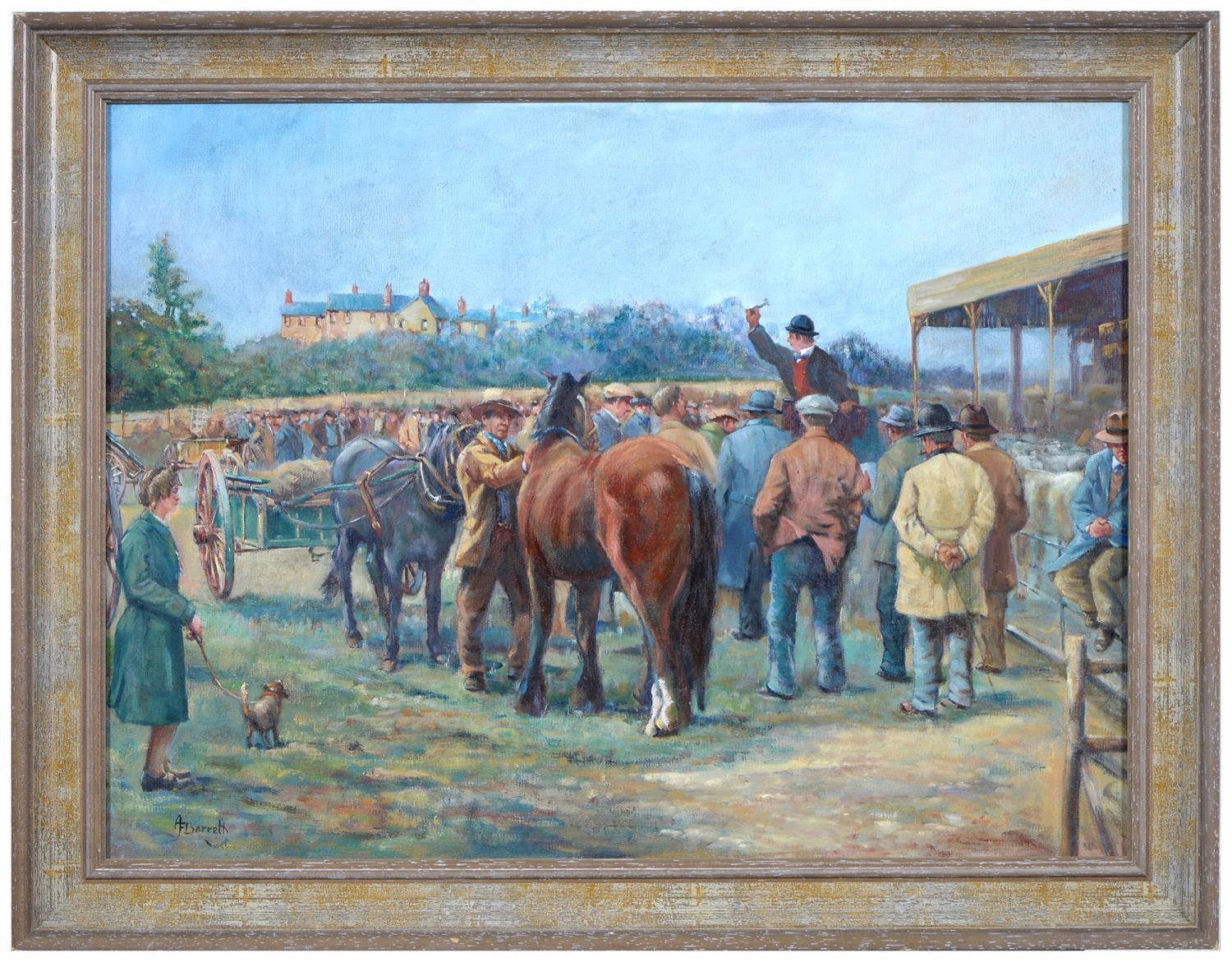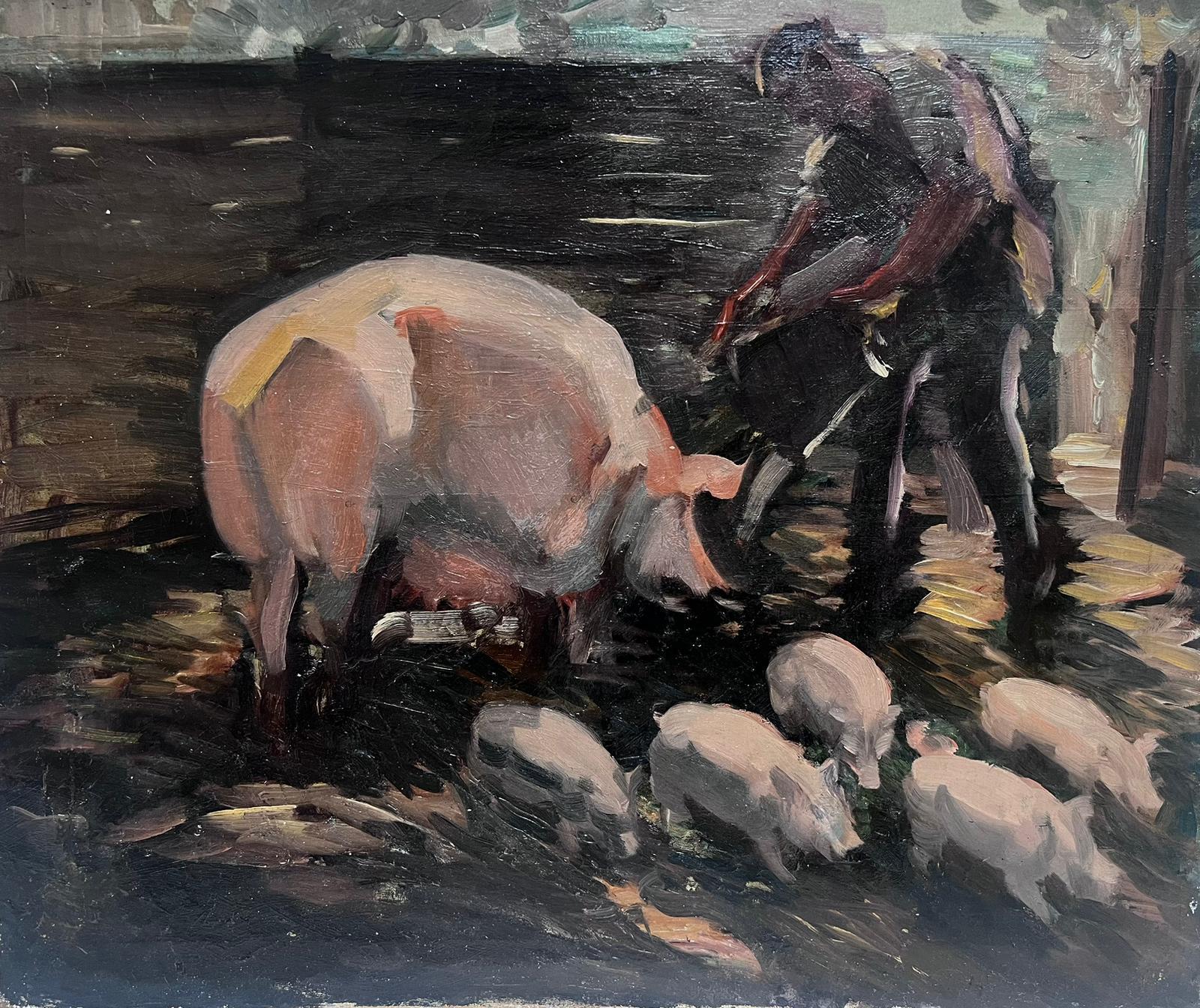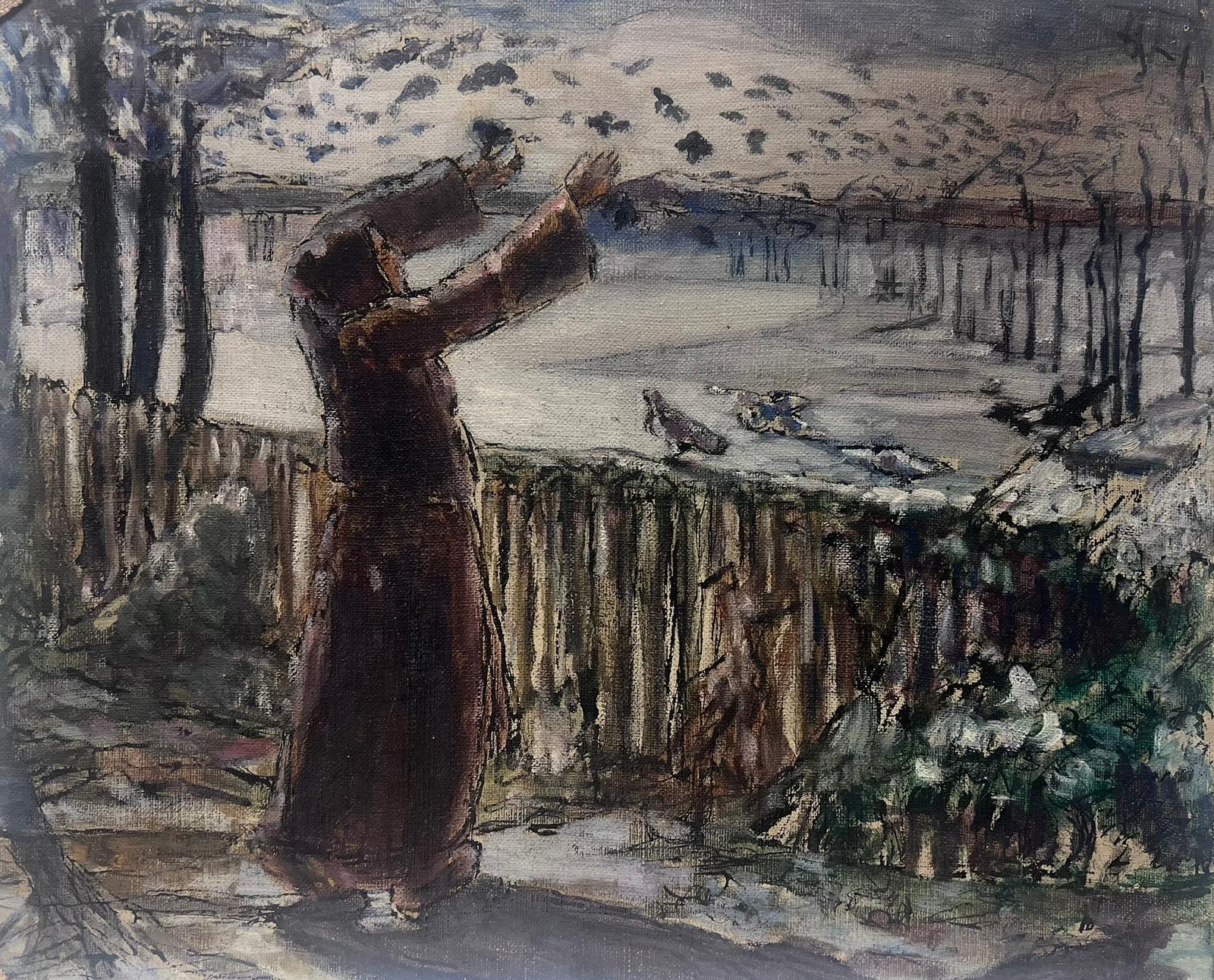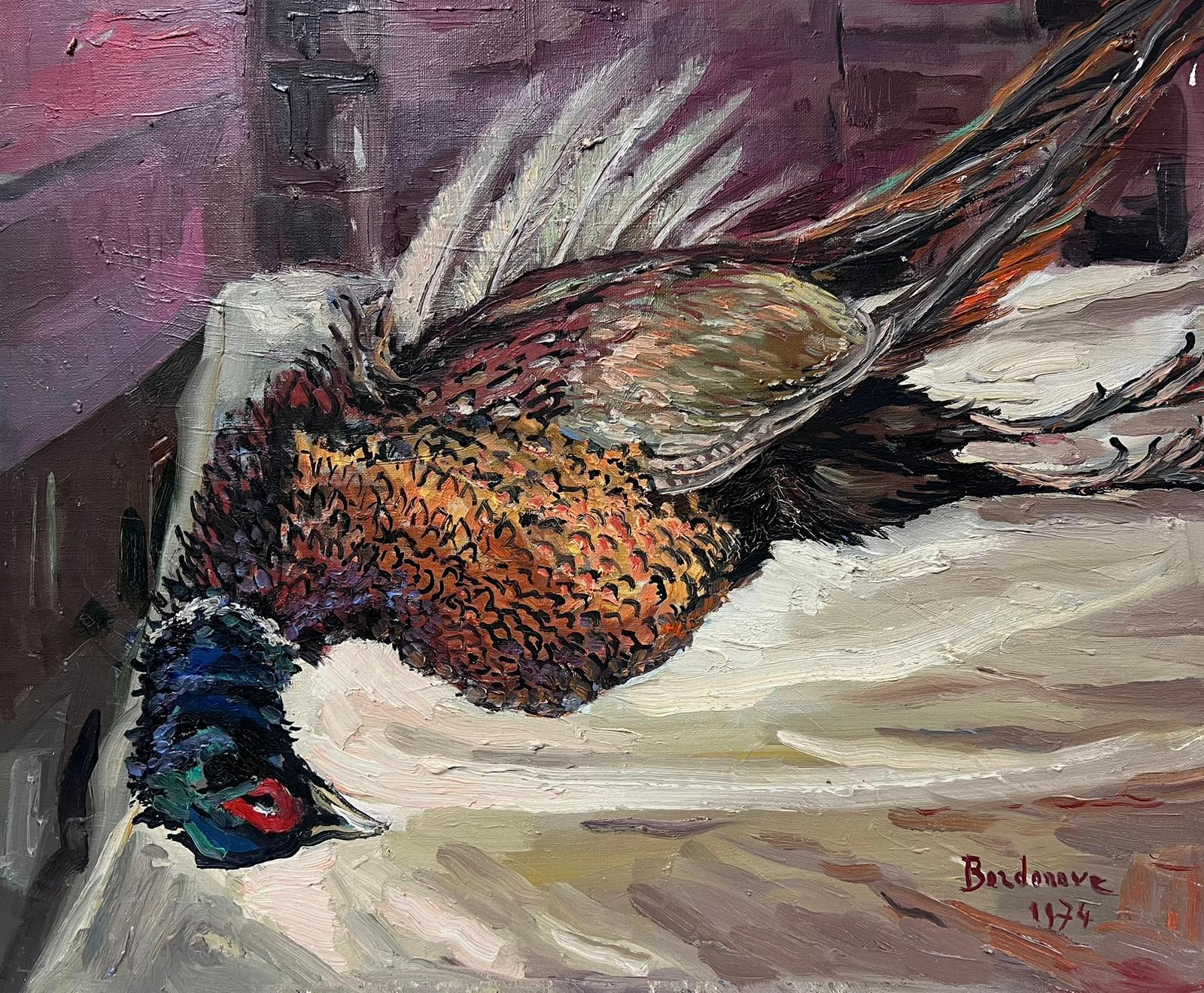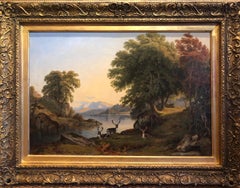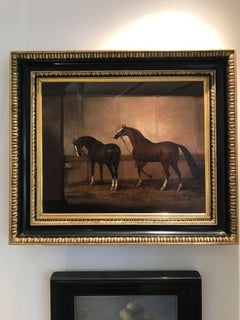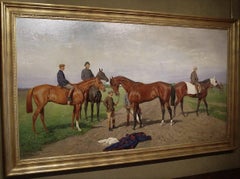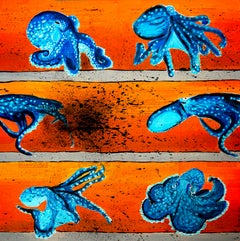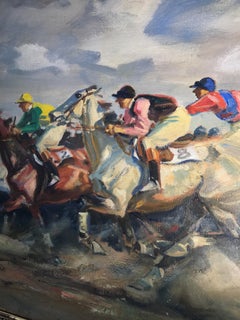
Impressionist 1910 Oil Painting by Angelo Jank of The Finish, The Horse Race
View Similar Items
Want more images or videos?
Request additional images or videos from the seller
1 of 8
Angelo JANKImpressionist 1910 Oil Painting by Angelo Jank of The Finish, The Horse Race1910
1910
$37,342.88List Price
About the Item
- Creator:Angelo JANK (1868 - 1940)
- Creation Year:1910
- Dimensions:Height: 38 in (96.52 cm)Width: 45 in (114.3 cm)
- Medium:
- Movement & Style:
- Period:
- Condition:
- Gallery Location:London, GB
- Reference Number:1stDibs: LU67334286781
About the Seller
5.0
Vetted Professional Seller
Every seller passes strict standards for authenticity and reliability
Established in 1990
1stDibs seller since 2017
42 sales on 1stDibs
Typical response time: A week
Authenticity Guarantee
In the unlikely event there’s an issue with an item’s authenticity, contact us within 1 year for a full refund. DetailsMoney-Back Guarantee
If your item is not as described, is damaged in transit, or does not arrive, contact us within 7 days for a full refund. Details24-Hour Cancellation
You have a 24-hour grace period in which to reconsider your purchase, with no questions asked.Vetted Professional Sellers
Our world-class sellers must adhere to strict standards for service and quality, maintaining the integrity of our listings.Price-Match Guarantee
If you find that a seller listed the same item for a lower price elsewhere, we’ll match it.Trusted Global Delivery
Our best-in-class carrier network provides specialized shipping options worldwide, including custom delivery.More From This Seller
View All19th Century Landscape Oil Painting - Deer by the Banks of a Lake
By Jacob Thompson
Located in London, GB
Jacob THOMPSON (1806 – 1879)
Deer by the Banks of a Lake
1842
oil on canvas
18.9 x 27.6 inches;
22.5 x 31 inches Inc. frame
Jacob Thompson (1806–1879) was an English landscape-pa...
Category
1840s Old Masters Figurative Paintings
Materials
Oil
18th Oil Painting Horses Feeding at the Stables
By James Seymour
Located in London, GB
James Seymour (1702–1752)
Feeding Time in the Stables
Oil on canvas
32 x 38 inches inc. frame
Provenance: Private Collection, Lambourn
James Seymour (1702–1752) was an English painter, widely recognized for his equestrian art.
Seymour was born in London. His father was an amateur artist and art dealer, whose other business dealings (as a banker, goldsmith, and diamond merchant) afforded young Seymour the leisure time to study art on his own, either his father's or the art at the Virtuosi Club of St. Luke - a gentleman's club his father belonged to, specializing in art. In a short time the boy was a self-taught artist, familiar with many of the prominent artists of the period.
Seymour's love of art was matched only by his love of horses. He began spending time at racetracks early on, and before long found himself absorbed in the sport - drawing, painting, owning, breeding, and racing horses. His art proved popular among the prominent sporting families of the day, eventually garnering Seymour patrons in Sir William Jolliffe and Charles Seymour, 6th Duke of Somerset...
Category
18th Century Old Masters Animal Paintings
Materials
Oil
Magnificent early 20th Century Oil Painting of Race horses - At the Gallops
By Julius von Blaas
Located in London, GB
Julius von Blaas (1845-1923)
At The Gallops
circa 1905
Oil on canvas
Signed and dated “Julius von Blass / 1905” (lower left)
110 x 200 cm (140 x 230 cms framed ish)
This enormous and grand depiction of horses exercising is an iconic image not only of the edwardien era but also of today’s racing elite.
Julius von Blaas was taught by his father Carl von Blaas (1815-1994) and trained in Venice, Florence and Rome. He was also influenced by his celebrated brother Eugen von Blaas...
Category
Early 20th Century Academic Animal Paintings
Materials
Oil
Grey stallion held by groom in Duke of Grosvenor’s colours British 18C
Located in London, GB
Richard Roper (British, c. 1730-c. 1775)
Grey stallion held by groom in the Duke of
Grosvenor’s colours
Oil on canvas
Old chalk inscription '22 Mar 74' verso
Property of a gentleman...
Category
18th Century English School Animal Paintings
Materials
Oil
1920s Famous Alfred Munnings Oil Painting of his Favourite Hound
By Alfred Munnings
Located in London, GB
Sir Alfred Munnings R.A. (1878 - 1959)
'Favourite Hound'
Oil on Wood
Framed 98 x 74 cm
Sir Alfred Munnings R.A. was known as one of England's finest painters of animals and as an ou...
Category
Early 20th Century Naturalistic Animal Paintings
Materials
Oil
$165,968 Sale Price
20% Off
Free Shipping
C19th Portrait Princesse de Joinville of Brazil - Spectacular fit for a palace
By Henri d'Ainecy Montpezat
Located in London, GB
Portrait of Princess de Joinville riding a Bay Horse
Henri d’Aincy, Le Comte Monpezat (French 1817-1859)
Painted circa 1837-9
oil on canvas
113 x 92 inches (including frame)
92 x 70 inches (unframed)
Provenance – from a private royal collection
This magnificent portrait depicts Princess de Joinville, the daughter of Pedro I, Emperor of Brazil and the King of Portugal. Through her illustrious family she was directly related Alexander III and Nicholas II of Russia and the Russian royal family, as well as to many of the great ruling families of Europe.
The work clearly confirms Monpezat as one of the most accomplished equestrian portrait painters in France in the early nineteenth century. In terms of scale, quality and dramatic power, it must surely be considered amongst his finest works. The stance of the powerful thoroughbred - in half rear - emphasises the calm nature and courage of the Princess.
Francisca of Brazil (1824-98) married a son of Louis Philippe I, the King of the French, and had three children. Born at the Imperial Palace of Saint Christopher, her youngest brother was the future Pedro II...
Category
1830s Old Masters Portrait Paintings
Materials
Oil
$293,210 Sale Price
20% Off
Free Shipping
You May Also Like
Young Girl with Her Cat
By Gunnar Donald Anderson
Located in San Francisco, CA
This artwork "Young Girl with Her Cat" c.1990 is an oil painting on panel by noted American artist Gunnar Donald Anderson, b.1927-2022. It is signed at the lower right corner by the artist. The panel size is 20 x 16 inches, framed size is 24 x 20 inches. Framed in a wooden gold frame, with fabric liner. It is in excellent condition.
About the artist:
Gunnar Donald Anderson, age 95 of Sonoma CA passed away on April 26, 2022. Gunnar was born to Sven Gunnar Anderson...
Category
Late 20th Century American Impressionist Animal Paintings
Materials
Oil
Bullfighting Scene oil on board painting
Located in Barcelona, Barcelona
Title: Bullfighting Scene
Artist: José María Tuser Vázquez (1919-1986)
Technique: Oil on board
Dimensions: 25.6 x 21.3 in (65 x 54 cm) Frameless
Period: Second half of the 20th century
Art Movement: Figurative Expressionism with Impressionist influences
Condition: Good, with visible signs of aging on the surface
DESCRIPTION OF THE WORK
This painting captures a crucial moment in a bullfight, where the matador, dressed in a dazzling traje de luces (suit of lights), elegantly holds the red cape (muleta) while facing a wounded bull. The scene conveys tension and drama through energetic and loose brushwork, with strong contrasts of light and color that enhance its expressiveness.
The abstract background, built with gestural brushstrokes in warm, earthy tones, reinforces the dynamism and immediacy of the moment. The thick texture of the paint and the vibrant colors in the matador's attire and cape are characteristic of Figurative Expressionism, giving the work a strong emotional impact.
Tuser masterfully captures the essence of movement and the intensity of the bullfight through a painterly approach reminiscent of Impressionism, but with a greater emphasis on gesture and expressive color, making his work stand out for its raw energy and dramatic depth.
ARTIST BIOGRAPHY
José María Tuser Vázquez (Barcelona, 1919 - 1986) was a Spanish painter specialized in bullfighting themes, gaining recognition in the 20th-century art scene for his expressive depictions of the corrida (bullfight). He studied at the School of Arts and Crafts in Barcelona, where he developed a strong mastery of color and composition.
From 1947 onwards, his work focused almost entirely on bullfighting, creating posters, illustrations, and paintings that capture the emotion and spectacle of the arena. He was a frequent collaborator with El Ruedo magazine, where his illustrations and covers solidified his reputation. Additionally, in the 1940s, he designed series of postcards featuring traditional Spanish costumes for the Artigas Publishing House.
His work has been auctioned in several art houses and is highly valued among collectors of bullfighting paintings. His influence and legacy in tauromaquia (bullfighting art...
Category
1950s Impressionist Figurative Paintings
Materials
Oil, Board
$955 Sale Price
33% Off
The Vagabond and His Dog oil on board painting
Located in Barcelona, Barcelona
Technical details of the painting
- Title: "The Vagabond and His Dog"
- Artist: Rosendo González Carbonell
- Technique: Oil on panel ...
Category
1970s Impressionist Figurative Paintings
Materials
Oil, Board
$716 Sale Price
25% Off
French School - Octopus walk (Large) NSWE - Oil Post Impressionist MAK
Located in Zofingen, AG
Octopus Walk NSWE
Serie of octopus walking...swimming.
Technique: oil, acrylic, and ink on old book pages on wooden frame 55x55cm ■■ 21,6x21,6 inch
Sustainability: Wooden frame ...
Category
21st Century and Contemporary Impressionist Animal Paintings
Materials
Ink, Oil, Acrylic
L'embarquement de boeufs - Impressionist Oil, Cattle by Jean Francois Raffaelli
By Jean-Francois Raffaelli
Located in Marlow, Buckinghamshire
Wonderful signed oil on panel cattle and figures in landscape by French impressionist painter Jean-Francois Raffaelli. The work depicts oxen being loaded onto ships in Honfleur, France en route to England.
Signature:
Signed lower right
Dimensions:
Framed: 18"x16"
Unframed: 9"x8"
Provenance:
Exhibition Jean Francois Raffaélli held at Galerie Simonson, 19 Rue Caumartin Paris - October 1929 (number 44)
Jean-François Raffaëlli's father was a failed Italian businessman and Raffaëlli himself was, among other things, a church chorister, actor and theatre singer. He then studied under Gérôme at the École des Beaux-Arts in Paris. He travelled to Italy, Spain and Algeria and on his return to France settled in Asnières.
In 1876, on a trip to Brittany, he first saw the potential of realist subject matter, if treated seriously. He became involved in meetings of artists at the Café Guerbois, where the Impressionist painters used to gather. As a result, Degas, contrary to the advice of the group, introduced Raffaëlli to the Impressionist exhibitions - according to one uncertain source as early as the very first exhibition, at the home of Nadar, and certainly to those of 1880 and 1881.
In 1904, Raffaëlli founded the Society for Original Colour Engraving. He first exhibited at the Salon de Paris in 1870 and continued to exhibit there until he joined the Salon des Artistes Français in 1881, where he earned a commendation in 1885, was made Chevalier of the Légion d'Honneur in 1889 and in the same year was awarded a gold medal at the Exposition Universelle. In 1906 he was made Officier of the Légion d'Honneur. He was also a member of the Société Nationale des Beaux-Arts. In 1884, a private exhibition of his work cemented his reputation.
He contributed to several newspapers such as The Black Cat (Le Chat Noir) in 1885 and The French Mail (Le Courrier Français) in 1886 and 1887. He published a collection entitled Parisian Characters, which captured his favourite themes of the street, the neighbourhood and local people going about their lives. In 1880 he participated, with Forain, on the illustration of Joris Karl Huysmans' Parisian Sketches (Croquis Parisiens). He also illustrated Huysman's Works. As well as working as an illustrator, he also made etchings and coloured dry-points.
His early attempts at painting were genre scenes, but once he was settled in Asnières he started to paint picturesque views of Parisian suburbs. From 1879 onwards, his subject matter drew on the lives of local people. These popular themes, which he treated with humanity and a social conscience, brought him to the attention of the social realist writers of the time such as Émile Zola. In addition to his realist style, Raffaëlli's dark palette, which ran contrary to the Impressionist aesthethic, helped to explain the opposition of those painters to his participation in their exhibitions. More concerned with drawing than colour, he used black and white for most of his paintings. Towards the end of his life, he lightened his palette, but without adopting any other principles of the Impressionist technique.
After painting several portraits, including Edmond de Goncourt and Georges Clémenceau, he returned to genre painting, particularly scenes of bourgeois life. Later in his career, he painted mainly Breton-inspired sailors and views of Venice. His views of the Paris slums and the fortifications, sites which have almost completely disappeared, went some way towards establishing a genre in themselves and perpetuated the memory of the area: The Slums, Rag-and-Bone Man, Vagabond, Sandpit, In St-Denis, Area of Fortifications. His realistic and witty portrayal of typical Parisian townscapes accounts for his enduring appeal.
Born in Paris, he was of Tuscan descent through his paternal grandparents. He showed an interest in music and theatre before becoming a painter in 1870. One of his landscape paintings was accepted for exhibition at the Salon in that same year. In October 1871 he began three months of study under Jean-Léon Gérôme at the École des Beaux-Arts in Paris; he had no other formal training.
Raffaëlli produced primarily costume pictures until 1876, when he began to depict the people of his time—particularly peasants, workers, and ragpickers seen in the suburbs of Paris—in a realistic style. His new work was championed by influential critics such as J.-K. Huysmans, as well as by Edgar Degas.
The ragpicker became for Raffaëlli a symbol of the alienation of the individual in modern society. Art historian Barbara S. Fields has written of Raffaëlli's interest in the positivist philosophy of Hippolyte-Adolphe Taine, which led him to articulate a theory of realism that he christened caractérisme. He hoped to set himself apart from those unthinking, so-called realist artists whose art provided the viewer with only a literal depiction of nature. His careful observation of man in his milieu paralleled the anti-aesthetic, anti-romantic approach of the literary Naturalists, such as Zola and Huysmans.
Degas invited Raffaëlli to participate in the Impressionist exhibitions of 1880 and 1881, an action that bitterly divided the group; not only was Raffaëlli not an Impressionist, but he threatened to dominate the 1880 exhibition with his outsized display of 37 works. Monet, resentful of Degas's insistence on expanding the Impressionist exhibitions by including several realists, chose not to exhibit, complaining, "The little chapel has become a commonplace school which opens its doors to the first dauber to come along."An example of Raffaëlli's work from this period is Les buveurs d'absinthe (1881, in the California Palace of Legion of Honor Art Museum in San Francisco). Originally titled Les déclassés, the painting was widely praised at the 1881 exhibit.
After winning the Légion d'honneur in 1889, Raffaëlli shifted his attention from the suburbs of Paris to city itself, and the street scenes that resulted were well received by the public and the critics. He made a number of sculptures, but these are known today only through photographs.[2] His work was also part of the painting event in the art competition at the 1912 Summer Olympics. In the later years of his life, he concentrated on color printmaking. Raffaëlli died in Paris on February 11, 1924
Museum and Gallery Holdings:
Béziers: Peasants Going to Town
Bordeaux: Bohemians at a Café
Boston: Notre-Dame; Return from the Market
Brussels: Chevet of Notre-Dame; pastel
Bucharest (Muz. National de Arta al României): Market at Antibes; Pied-à-terre
Copenhagen: Fishermen on the Beach
Douai: Return from the Market; Blacksmiths
Liège: Absinthe Drinker...
Category
1880s Impressionist Animal Paintings
Materials
Oil, Panel
"Little girl with dog " Oil cm.35 x 25 1950
By Klara Vlassova
Located in Torino, IT
Dog,Child,Little girl,impressionisme
KLARA VLASOVA (Moscow, 1926)
MUSEUMS
St. Petersburg, State Russian Museum
Moscow, Pushkin Museum
Moscow, Museum of History and Reconstructio...
Category
1950s Impressionist Animal Paintings
Materials
Oil
Recently Viewed
View AllMore Ways To Browse
Kate Paul
Carl Wilhelms
Karl Gatermann Paintings
Karl Gatermann
English Hunt Paintings
Oil Painting Of Parrots
Hunt Board
Rabbit China
Rooster Oil Painting
Horse And Jockey Painting
Horse Painting On Silk
African Jungle
Outsider Art Cat
Antique Oil Painting Terriers
Gold Rabbit Painting
Polo Equestrian
The Goldfinch
Hummingbird Oil Paintings
